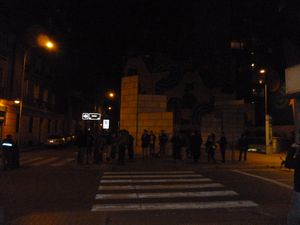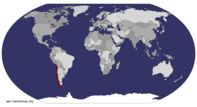Advertisement
Published: November 9th 2011

 Belles Artes
Belles Artes
Banging pots and pans for the strat of General StrikeIt is certainly a most interesting time to be in Chile.
I always knew that the Chileans were not afraid to have the odd strike, demonstration and protest. It's part of the reason why Chile attracted Dee and I so much. We wanted to go some place where the people were actively pushing back - against corporate greed. Well Chile has it in spades.
In our first week, there was a nation wide general strike on the 24th and 25th August. On the 25th, it was particularly effective as all transport workers went on strike. Bus drivers were driving their buses to protest meetings, those who crossed the picket line had their buses paint bombed and in a couple of cases molotov cocktailed.
The day before we saw a protest by bank employees outside Banc de Chile. They were demonstrating about poor working conditions and low pay while the Banc enjoyed huge profits. These people were normal middle class employees. This was the first indication for us of the broad based anger and disenchantment the Chileans have for the current government under Pinera an ex Pinochet government member. Needless to say, the right wing dominated government supports all things

 Belles Artes
Belles Artes
People come and go, others lean out of their windows aka Newsfront.neo-liberal. Most Chileans seem to support the ongoing protests. As far as I can make out, Chileans work 45 hours per week, earn not much more than $10 per hour and experience relatively high inflation. Petrol and milk cost about the same in Oz. No wonder the middle classes are complaining, especially when much is made of Chile's prosperity due to its natural resources, mainly copper. It is a wealthy country. Yet 22% of its population is below the poverty line. (This may be wrong as I read this in Spanish and let's face it, my Spanish is crap!)
Also, Chile is rife with huge multinationals, monopolies and oligarchies. They don't even have access to fresh milk. The only milk available is UHT and this supply is controlled by a US and Spanish duopoly.
The other really big issues here are education and health. These basic human rights are largely privatised and are usually owned by US interests. The students have been particularly effective in their protests.
The price of education here is astronomical. We were told that a year of University education costs the equivalent of three years of an average worker's wage. Only the very wealthy

 Looking towards Universidad de Chile
Looking towards Universidad de Chile
Protest broken up by tear gas and water cannoncan afford a university education. Added to this is the inequity that exists between the poorly funded state education system and the private schools. If you are poor there is no access to quality education. Even the middle class struggle to access good quality education. The problem lies in large investment companies and corporations owning educational institutions. When Pinochet in the 80s privatised everything, he sold off the State Universities to large US investors who promptly charged the universities rent for the land they occupied. Student fees have had to be increased in order to pay for these rents rather than going into infrastructure, teaching, research and learning. The students have had enough.
No Lucre! Educacion gratis!!
Much has been made of 23 year old Camila Vallejo, a member of the Communist Party and President of the National Student's Union. She is the vibrant, charismatic poster girl of the Left. It is reported that about 70% of Chileans support her.
The student movement has used some pretty novel ideas for protest. In July, they staged a kiss-a-thon where 1000s of students amassed in front of the Moneda (the Presidential Palace) and kissed for hours before going on a

 Nacional Bibliotec
Nacional Bibliotec
Cut up paper is often used in manifestacionsmarch. Another march had a large group on skateboards. A common sight is groups of young people jogging with banners and flags. haven't quite worked what that is about yet. They also staged a zombie protest march in October. Every week here there is a manifestacion.
The most amazing, courageous and inspired action, I think, has been the occupation of the schools and universities. Students across the country in May took over their schools. They barricaded the gates and fences with school chairs and desks and refused to do any work. One notable successful girls secondary school in affluent Providencia has staged a sit in since May. They have successfully withstood police raids and remain determined to keep the school unopened until the government addresses the inequalities in the system. They have meetings every day to divvy up the daily chores. They sleep, eat and live there. University lecturers, including a notable astronomer, have been providing free tuition for them, radio stations and bands stage events there at lunch time to relieve the boredom and their parents support them. The girls have made some rules: no boys, no sex, no alcohol. Thus far, they have been very successful in
their campaign.
Another important site for action is the Universidad de Chile. Again, the students have occupied it since May. The students have also championed the fight of the Mapauche People who are fighting against racism and unlawful detention. Several young Mapauche men have been sent to prison for protesting and had gone on a hunger strike. Patagonia libre! Every day there are broadcasts, petition signing, art works, music. Grafitti and banners adorn the neoclassical facade of the University's entrance. The statue outside wears a tear gas mask. This is often the site of lots of conflict with the police.
Each protest and manifestacion is heralded by the beating of drums and the banging together of pots and pans. This is to call the people to the streets. We have witnessed many of these and joined in a couple of them! The street dogs love it and get quite stirred up by the commotion. Its great to be standing in the middle of a barricaded street with loads of others - all ages - making a lot of noise and voicing one's discontent and anger at how a government actively promotes inequality.
We have also inadvertently been

 Universidad de Chile
Universidad de Chile
Major site for protests and demos.caught up in the demos and in the police action which inevitably follows. many a time we have been out walking in the barrios only to be suddenly engulfed in a cloud of left over tear gas, making our eyes water and lungs cough. Early on, we went to see what was happening at the Universidad de Chile, thinking we were far enough away from any trouble, only to find ourselves running away from a water cannon truck - a guanaco- which started shooting at the crowd. To escape we ran straight into a restaurant in Paris Street behind the Uni.
I have been scared twice. The first time, I was walking home from work, deep in thought and I passed by the Universidad de Chile. I wondered why the path was covered in rocks and the crowd had thinned out. Next thing I knew, a guanaco was backing up over the gutter and almost over me so that it could better aim its water cannon at a group of students holed up in the Uni who were throwing rocks and molotov cocktails at the police. It then turned its cannon on the bystanders , all of whom were
like me, just making their way home from work. I stated to run as fast as i could, swearing furiously and stumbling over the uneven pavement. The middle aged Chilean man running beside me found my swearing hilarious! or maybe he was just laughing at the sight of a large, middle aged Gringo, shaking her fist at the cops while stumbling running.
Another time, Dee and I were out and about on a Sunday afternoon in Centro and we were wondering at the number of cops out on the street. We were heading to Cerro Santa Lucia for 'onces' ( an afternoon bevvy and snack) when a khaki coloured, wire encased jeep stopped at the curb and pumped out a serious amount of tear gas directly at the people on the pavement. everyone ducked and dived to protect themselves from getting too much tear gas. Dee ran off, unfortunately in the same direction that the tear gas was blowing and straight into a riot that was occurring just around the corner unbeknownst to us. I knew I couldn't run fast enough so I hid behind a news kiosk and missed most the tear gas cloud. When Dee soon made his way back to me, he was in a mess. Tear gas stings a lot!!!
The carabineros (police) certainly respond forcefully. They provide a constant presence - on foot, with dogs, on horses, on motorbikes, in guanacos and tear gas jeeps. They are suited up like khaki ninja turtles and take no prisoners showing more concern for the street dogs than the passing general public. Their overeaction to protests is very provocative and many people have been injured and even killed as a result. The students can be quite destructive. Any building site is quickly utilised for its ammunition. Street paving is pulled up and used as missiles. Setting fire to rubbish bins and pulling up bollards and signage is common, as is the smashing of bus shelter advertisng and advertising billboards. Banks and financial service buildings and offices cop it as well, often sporting shattered glass windows and doors. This is usually the work of the 'hooded ones', usually disaffected young men. Unlike London, though, they seldom target ordinary shops - only multinational corporation department store types. And the police certainly hit back disproportionately.
The protests are working. The government has been forced to talk to the students. However, as yet, it hasn't borne fruit. The student leaders have taken their fight to the international stage and there doesn't seem to be an end to the protests for awhile yet. Viva la revolucion!
Advertisement
Tot: 0.067s; Tpl: 0.012s; cc: 6; qc: 44; dbt: 0.0424s; 1; m:domysql w:travelblog (10.17.0.13); sld: 1;
; mem: 1.1mb










Lyn
non-member comment
Brilliant!!!
Brilliantly written and such an interesting read!!! xxx